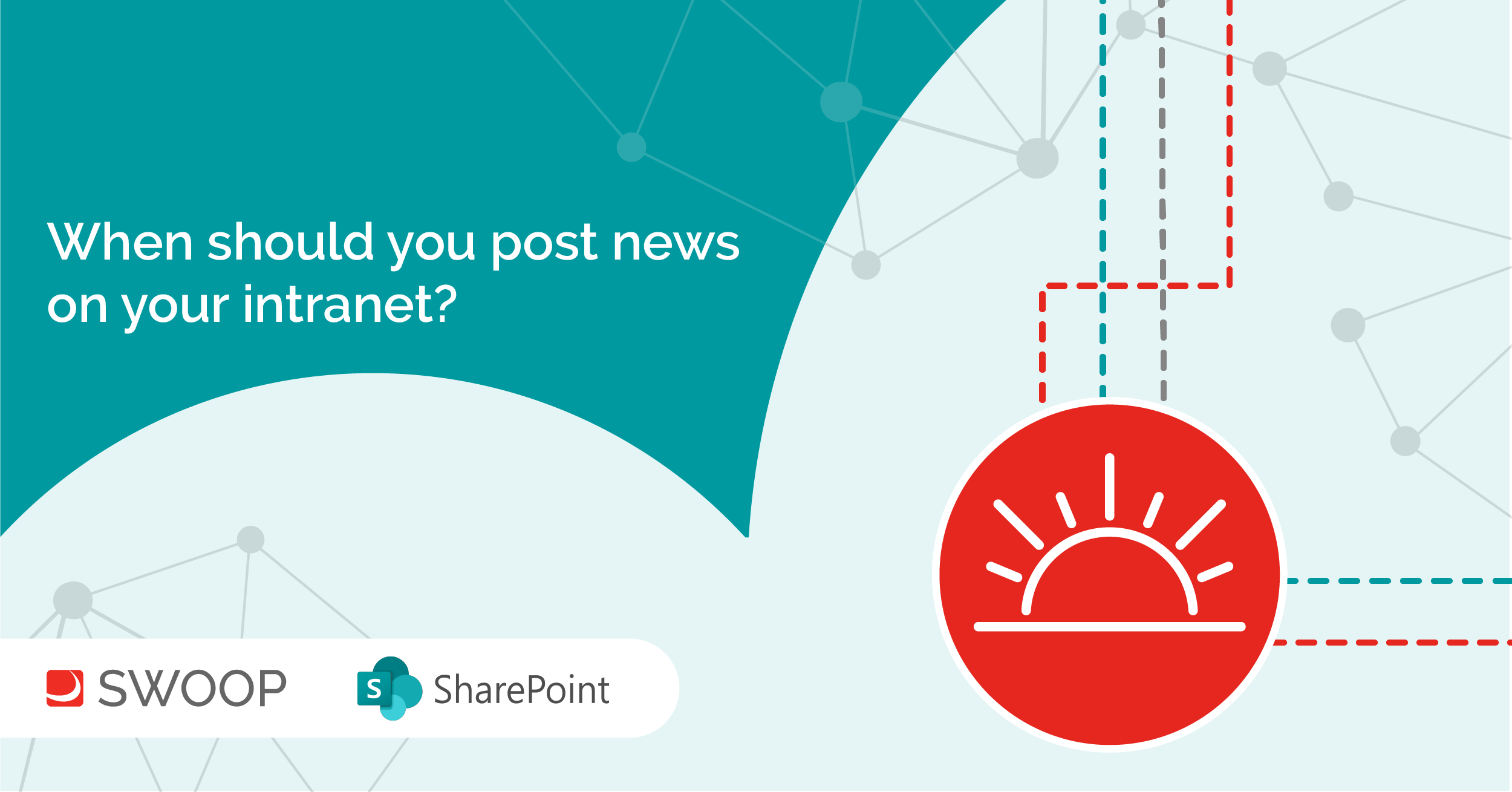When should you post news on your intranet?
When is the best time to post a news item on your intranet? The answer to this question could be the silver bullet for anyone involved in internal communications. (Spoiler – if you have Mondayitis, you may not want to know the answer!)
SWOOP Analytics’ benchmarking study of SharePoint intranets found the most popular times for reading the intranet is 7am-9am or 11am-1pm on a weekday, with Thursday being the best day. However, news is being consumed any time during normal working hours of 8am–6pm.
As a general rule of thumb, employees tend to read news mostly at the beginning of the day (7am–9am) and again at the midday break (11am-1pm). However, news is being consumed any time during normal working hours of 8am–6pm. Source: SWOOP Analytics’ SharePoint Intranet Benchmarking Report.
Intranet news is read liberally on each weekday (Monday to Friday). Thursday is marginally a better day for news reading and Friday the least. Source: SWOOP Analytics’ SharePoint Intranet Benchmarking Report.
Jonas Bladt Hansen, co-founder, Next Level IC.
With these findings in mind, we asked a panel of intranet specialists and thought leaders when they would recommend news items be posted on the intranet for maximum engagement.
Jonas Bladt Hansen, co-founder of Danish internal communications consultancy Next Level IC, says this finding aligns with his vast experience and knowing when most people consume news items on the intranet gives internal communicators the data they need to create an engaging content plan.
“In other words, prioritise the content that should have the most attention in the beginning of the week,” Jonas said.
Chris Harrer, Assistant Vice President, Internal Communications – Digital, Comcast.
Chris Harrer, Assistant Vice President, Internal Communications – Digital, at US-based technology and entertainment giant Comcast, says he finds Monday mornings at 7am, and Wednesday or Thursday mid to late mornings, are key times to publish content.
“We see a burst of readership on Monday mornings and then lunch and end of day during mid-week,” Chris said.
Another factor to consider when publishing a news article on the intranet, Chris says, is to take into account when the company newsletter goes out.
“The company newsletter is always a generator of readership on the intranet, so you need to take that into account when publishing content,” he said.
“Our main newsletter goes out on Wednesday late morning which does impact the Wednesday lunch rush or end of day readership.”
Jonathan Phillips, co-founder, Lithos Partners.
Jonathan Phillips, co-founder of Lithos Partners, a UK-based digital communication and collaboration consultancy, agrees with SWOOP’s findings for the most popular times to read news on the intranet but issues a warning. If everyone publishes their news at the same time, nothing will be in the spotlight.
“While it’s worth taking a look at your own data to identify peak reading times, if everyone tries to target the same optimum time you end up with everything being published at the same time and no story getting its time in the spotlight,” Jonathan said.
“More important is to ensure you have a regular cadence of comms, so there’s always fresh content. Data can help with that ‘air traffic control’.
“Take some time to understand how your people work – their working hours and peak busy times – and think how you can make your comms work for the way that people work so that comms gets visibility at the times when people are most likely to engage with it.”
Jonathan also has an interesting take as to why Thursdays may be the popular day for employees to read content.
“People open up their browsers at the start of their working day, and if there’s news to catch their eye they’ll take a few minutes to read it,” he said.
“They might do the same when stopping for lunch or picking up afterwards.
“The shift to hybrid means Thursday is the last day in the office for many, which may explain the Thursday peak.”
Principal Digital Workplace Consultant at intranet consultant Step Two, Rebecca Rodgers, says the question of when to post on an intranet is the topic of many discussions. Rebecca said it’s important to understand the target audience for your message and to schedule the intranet post when that audience is most likely to read it.
Rebecca Rodgers, Principal Digital Workplace Consultant, Step Two.
“For frontline employees at a bank, the sweet spot was 8.10am which is when they were waiting to be let into the branch for the day,” she said.
“At a not for profit, it was towards the end of their break time as they were client facing the rest of the time.”
Rebecca says the broader message is that the timing of news should be contextualised, around a deep understanding of target audiences.
“This can be helped by creating internal communication strategies that focus on the type of news (leadership messages versus crisis comms) and audience group (office, frontline, field) rather than focusing on channels (intranet or Viva Engage),” she says.
“This will help internal communicators (and leaders) to confidently use the right method of delivery for a specific audience and message, rather than scatter-gunning across multiple channels.
“Time of delivery is then considered as one element of this holistic approach.”
Jamie Stokes, Director, Digital Communications, Cox Enterprises.
Jamie Stokes, Director, Digital Communications at Cox Enterprises, America’s largest private broadband company, said in her experience, the time of posting on the intranet didn’t make much difference, but frequent rotation in our curated featured news on the homepage would boost engagement.
“Having fresh content there was key,” Jamie said.
“We saw similar consumption patterns as noted above, more so during morning hours.”
Suzie Robinson, consultant at specialist intranet consultancy ClearBox Consulting, says while SWOOP’s benchmarking findings align with her experience, popular intranet reading times can vary between organisations depending on things like the timing of repeated tasks (for example, after completing time sheets on a Friday afternoon) or regular meetings (waiting for an all company briefing on Monday afternoons).
Suzie Robinson, consultant, ClearBox Consulting.
Suzie says there are also benefits to be had from consistency, such as posting a particular type of news at the same time each week or month, so readers understand the publishing schedule and are prepared to read something.
“The volume of news and the design of the home page will also influence the best times to post on an intranet,” she said.
“These are factors to consider in isolation and in combination. For example, an intranet with a high volume of news will need to have identified a way to make high priority messages stand out on the home page so they aren’t smothered.
“This may then impact the chosen publication days/times.”
Suzie says the best time to share news is therefore when it’s most appropriate for the audience, as well as for the nature of the message and intranet publishing practice.
“For those with a global audience this can be a challenge, so means the day rather than the time will likely be of greater importance for some messages,” she said.
“Checking analytics, like SWOOP, is definitely an important step to take to understand what’s appropriate for your organisation.”
Susan Hanley, Microsoft SharePoint and M365 specialist.
For a completely different take on when to publish on the intranet for maximum readership, Microsoft SharePoint and M365 specialist Susan Hanley pointed to an Axios HQ report which found the best time to send email comms is Sunday between 3-6 pm.
“I think the assumption is that news would be read Monday morning or Sunday evening as people prepare for work,” Sue said, adding that most of her clients prefer first thing Monday mornings as a time to publish news.
“But I think this really begs the question of where our consumers want to read their news.”
From her extensive research and stakeholder interviews, Susan said almost everyone says they prefer to get their news from email.
“Microsoft recently publicly announced a new feature that allows communicators to use a specific page template in SharePoint that is formatted for email and, when posted, effectively sends a snapshot of the entire page via email rather than the current feature which sends a page summary and a link that a user needs to click to read the full article,” Susan said.
“One of my clients publishes an email newsletter ‘Three Things You May Have Missed’ every Monday morning. While they are ‘aspirationally’ planning to use a SharePoint news digest to send this summary – the goal is to meet users where they are, which is email.”
Susan suggests rather than looking just at when to post news on the intranet, look at which channel is best for news consumption.












